
Ina is a peculiar small depression on the Moon, in Lacus Felicitatis. It is D-shaped, 2.9 km × 1.9 km wide and 64 m deep.

The geology of Mercury is the scientific study of the surface, crust, and interior of the planet Mercury. It emphasizes the composition, structure, history, and physical processes that shape the planet. It is analogous to the field of terrestrial geology. In planetary science, the term geology is used in its broadest sense to mean the study of the solid parts of planets and moons. The term incorporates aspects of geophysics, geochemistry, mineralogy, geodesy, and cartography.

In geology, a depression is a landform sunken or depressed below the surrounding area. Depressions form by various mechanisms.
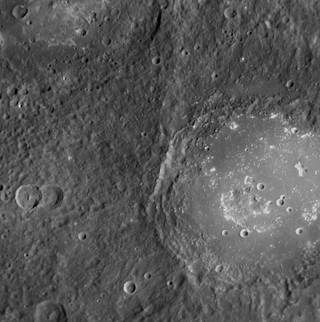
Lermontov is an impact crater on the planet Mercury. The crater is named after Mikhail Yuryevich Lermontov, a 19th-century Russian poet. The name was approved by the International Astronomical Union in 1976.

Raphael is a crater on Mercury. Its name was adopted by the International Astronomical Union (IAU) in 1976, and is named for the Italian painter Raphael.
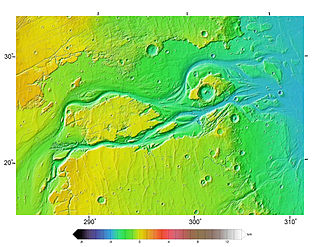
Outflow channels are extremely long, wide swathes of scoured ground on Mars. They extend many hundreds of kilometers in length and are typically greater than one kilometer in width. They are thought to have been carved by huge outburst floods.

Praxiteles is a crater on Mercury. It is one of 110 peak ring basins on Mercury.

Navoi is a crater on Mercury. It contains uncommon reddish material that indicates a different rock composition from its surroundings. Navoi also appears to have an irregularly shaped depression in its center. Such depressions have been seen elsewhere on Mercury, including within Praxiteles crater, and may indicate past volcanic activity.
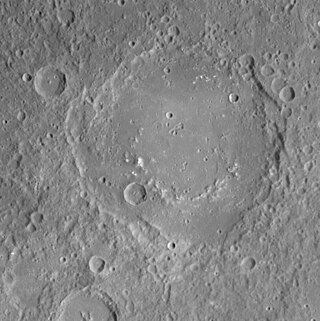
Al-Hamadhani is a crater on Mercury. It has a diameter of 186 kilometers. Its name was adopted by the International Astronomical Union in 1979. Al-Hamadhani is named for the Iranian writer Badi' al-Zaman al-Hamadani, who died in 1007 C.E.

Geddes is a crater on Mercury. It has a diameter of 84 kilometers. Its name was adopted by the International Astronomical Union (IAU) in 2010. Geddes is named for the Irish stained glass artist Wilhelmina Geddes, who lived from 1887 to 1955.

Hitomaro is a crater on Mercury. It has a diameter of 105 kilometers. Its name was adopted by the International Astronomical Union (IAU) in 1976. Hitomaro is named for the Japanese poet Kakinomoto no Hitomaro, who lived from the 650s to roughly 709.

Kipling is a crater on Mercury. It has a diameter of 164 kilometers. Its name was adopted by the International Astronomical Union (IAU) in 2010. Kipling is named for the British author Rudyard Kipling, who lived from 1865 to 1936.
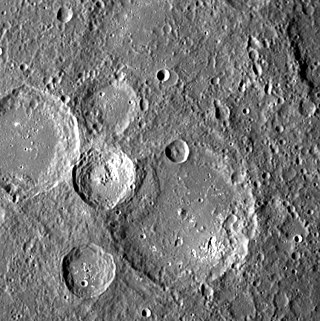
Mistral is a crater on Mercury. Its name was adopted by the International Astronomical Union (IAU) in 1976. Mistral is named for the Chilean poet Gabriela Mistral, who lived from 1889 to 1957.

Mussorgskij is a crater on Mercury. It has a diameter of 125 kilometers. Its name was adopted by the International Astronomical Union (IAU) in 1979. Mussorgskij is named for the Russian composer Modest Mussorgsky, who lived from 1839 to 1881.

Occator is an impact crater located on Ceres, the largest object in the main asteroid belt that lies between the orbits of Mars and Jupiter, that contains "Spot 5", the brightest of the bright spots observed by the Dawn spacecraft. It was known as "Region A" in ground-based images taken by the W. M. Keck Observatory on Mauna Kea.

Enheduanna is a crater on Mercury. It has a diameter of 105 kilometers. Its name was suggested by Gagan Toor from India in a naming contest which was eventually adopted by the International Astronomical Union (IAU) on 2015. Enheduanna is named for the Sumerian poet Enheduanna. The craters Carolan, Kulthum, Karsh, and Rivera were also named as part of the contest.

Nathair Facula is a bright region on the surface of Mercury, located at 36° N, 295.5° W. It was named by the IAU in 2018. Nathair is the Irish word for snake.
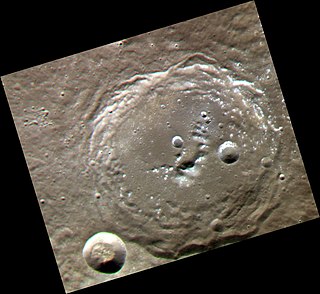
Boznańska is a crater on Mercury. Its name was adopted by the International Astronomical Union (IAU) on September 25, 2015. Boznańska is named for the Polish painter Olga Boznańska.

Donelaitis is a crater on Mercury. Its name was adopted by the International Astronomical Union (IAU) on May 15, 2013. Donelaitis is named for the Lithuanian poet Kristijonas Donelaitis.
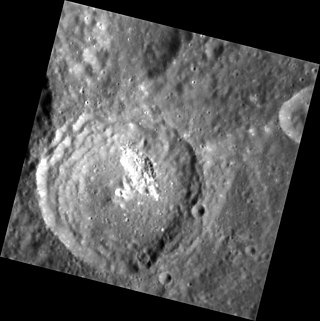
Veronese is a crater on Mercury. It has a diameter of 45 kilometres. Its name was adopted by the International Astronomical Union (IAU) on June 28, 2021. Veronese is named for the Italian painter Paolo Veronese.





















